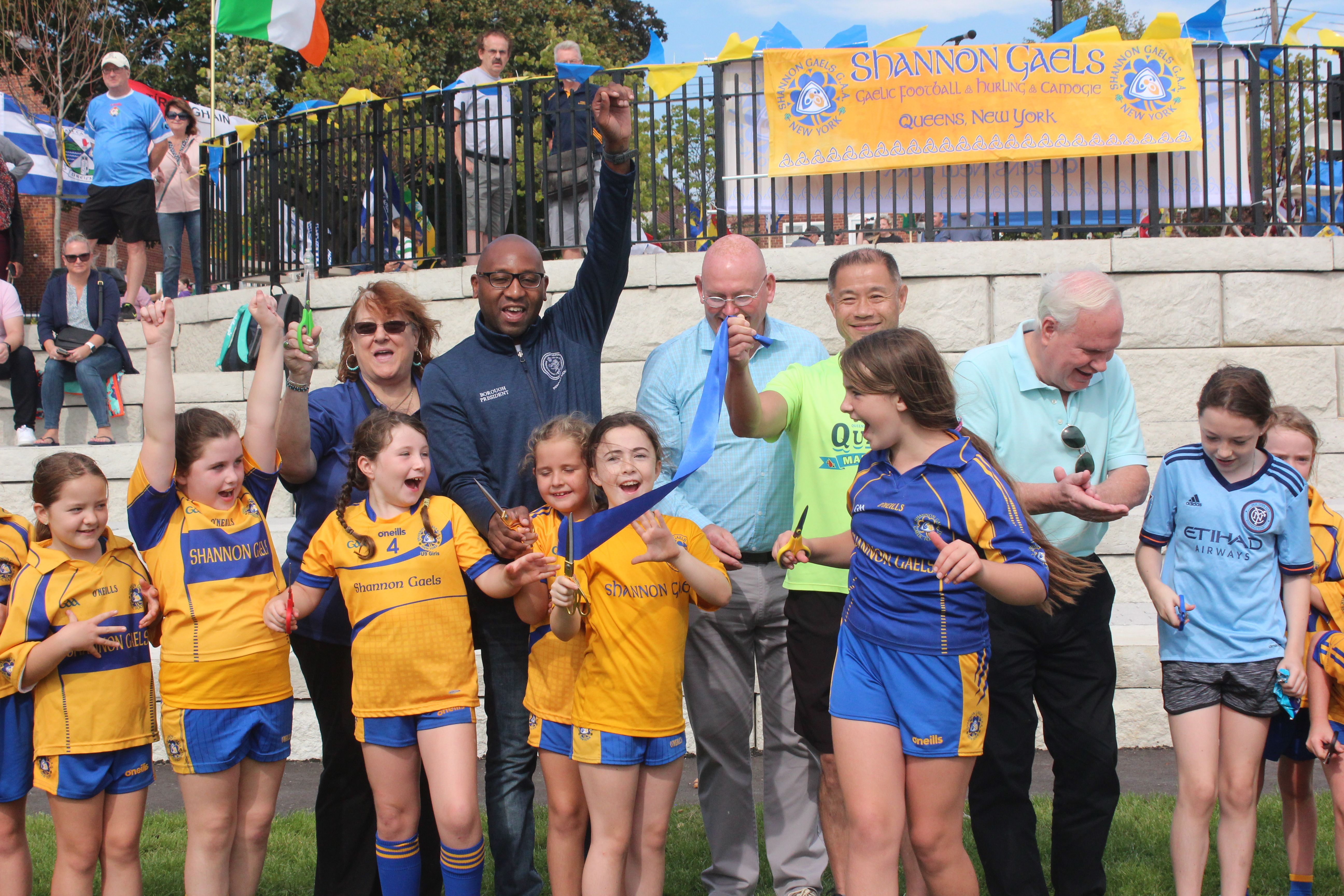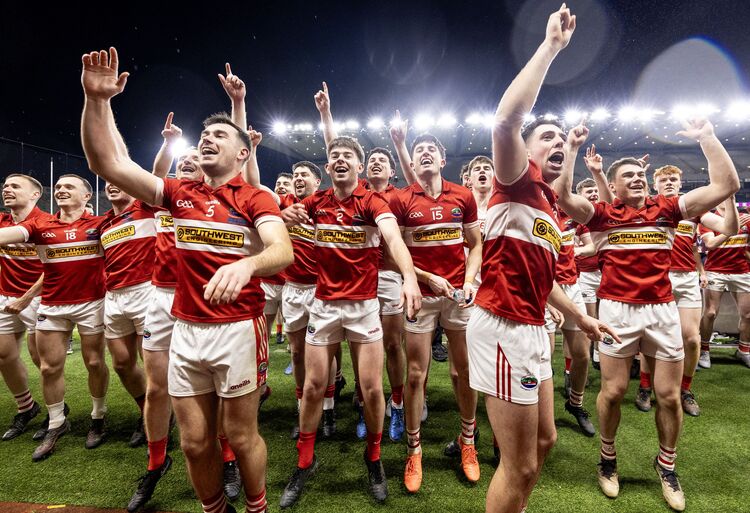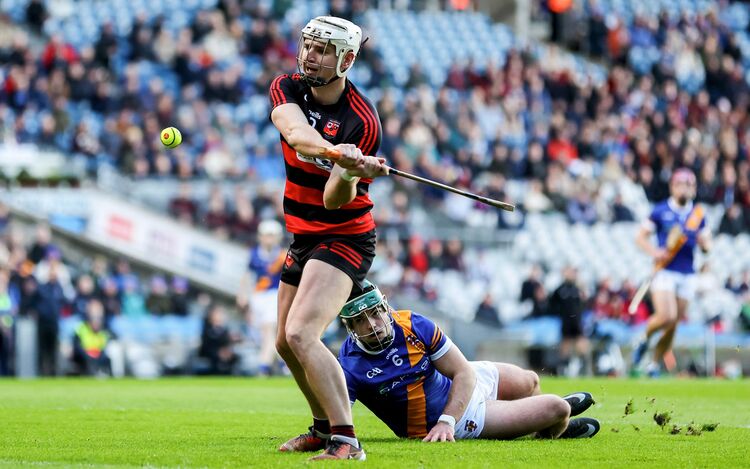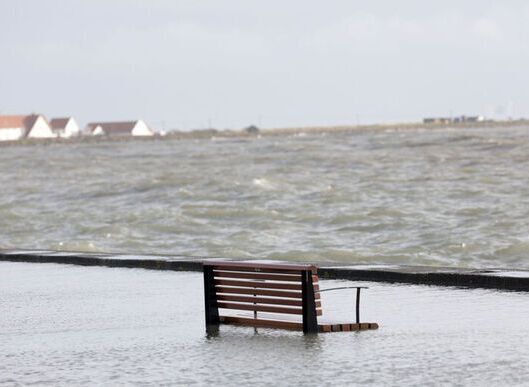Shannon Gaels and friends celebrating the October opening of their new facility in Queens.
A few weeks ago, on a sunny Saturday in October, at Frank Golden Park in the College Point section of north Queens, in New York City, the Shannon Gaels, a Gaelic Athletic Association club, cut the ribbon on its Field of Dreams.
The event, long in the making, was very much a newsmaker. After two decades of hard work and commitment by primarily Irish immigrants and Irish Americans, the boys and girls of Queens now had a home of their own to learn the ancient skills of Gaelic games, and proudly host competitive matches all the way up to the senior (adult) levels. These Gaelic games include Irish football, hurling, for the boys, and camogie, for the girls.
Twelve years before, in 2009 and again on an October Saturday, the weather was nowhere near as lovely for another well-publicized day for the Shannon Gaels.
That was the day then New York City Mayor, Michael Bloomberg, came to visit the fledgling club at their field at the time, Sunnyside Gardens. The more politically cynical might suggest it was a ploy by Bloomberg to round up a few extra Irish votes in the run-up up to another election, but whatever the motive, the Mayor said it had been a real honor on that windswept and wet afternoon to spend time with the club’s coaches, organizers, parents and the kids themselves, decked out in their blue and yellow team uniforms.
It was Irish community activist, Ciaran Staunton, who had coaxed a busy Bloomberg to come to Sunnyside to begin with, and who had then used his considerable political acumen to extract a pledge from his high-profile guest, before sending the Mayor on his merry way, sworn to the task of locking in a piece of city-owned Queens land for the club, to be fully devoted to Gaelic games, and meeting the specifications for a competitive host venue as outlined by the GAA, the games’ international governing body, headquartered in Ireland. That venue-to-be-named-later turned out to be Frank Golden Park.
Because, as endearing and cozy as Sunnyside Gardens was, it fell very short as a venue for the many competitive games and training sessions at all age levels the club already fielded, and for the expansion of the club its organizers envisioned.
For one thing, “there was no such thing as going behind the goals to retrieve the ball," long-time dedicated volunteer Robert Corridan, a general contractor from County Kerry, recalls.
“There was no ‘behind-the-goals.' It was such a small field, we tied the goalposts onto the fences at each end. And there was very little grass there,” he added. “On hot summer days you would see a dust cloud moving around and a bunch of kids in the middle of it.”
Parking was no picnic either. The club’s Treasurer, Limerick woman Emer Quinlan, remembers how Corridan would come to the gates of Sunnyside Gardens to fetch her son from her while she drove around to find a spot for her vehicle.
Founded by five immigrants from Ireland, Michael O'Reilly, Anthony Gaughan, John Nicholson, Pat Hurley and the late Tom Kerins, by 2009 the club had been in existence for eight years, but those earlier years were akin to being in a dust cloud for the founders and an early set of committed parents. Growing a club from scratch, with little resources other than a passion for Gaelic games, was something none of them had done. But interest in the club was growing slowly over time, so they stuck at it.
The needle began to move in and around 2008, when the influx of parents, eager to have their young kids play the games of their own childhood in Ireland, reached a critical mass. It was time to take things up a notch. McClancy High School and other fields were used for training and games, and the club turned its hand to registering as a not-for-profit, which would open many new avenues for funding and support.
Quinlan, who describes herself as a "behind the scenes person, not so much a coach," with her background working in financial services, raised her hand to help get the not-for-profit status sorted. “It took quite a few months but we got it done,” she says.
This newly obtained status was key to asking for Bloomberg’s support. And so began the journey to the Field of Dreams.
Their nonprofit status subsequently allowed funding to flow from the City Council, the office of the Queens Borough President, and the Irish government. It afforded tax deductions for private individual and corporate donors. Along with in-kind contributions of time, labor and materials from many sources, this critical support all led to the recent official opening in College Point.
County Meath native and flooring contractor, Robert McDonagh, is coming to the end of a five-year stint as chair of the Shannon Gaels. He describes the arrangement with the city’s Parks Department for the use and development of Frank Golden Park as a maintenance agreement. “No money changes hands,” he says, but the Shannon Gaels are responsible for the upkeep and development of the grounds.
The club is roughly half-way through its first fifteen-year term. Other GAA clubs in the region, and even clubs outside the realm of Gaelic games, see the Shannon Gaels model as something to emulate.
The club began using Frank Golden Park a decade ago, but initially had to repurpose it from its prior life as a baseball field, and deal with drainage issues. The work to bring Frank Golden Park to its current standard began slowly in 2015, accelerating over time, and continuing through the pandemic.
The Shannon Gaels now has two playing fields, and can boast having the first full-sized GAA field ever in Queens. In David McNamara, from Co. Clare, the club employs a full-time development officer.
From the off, the Shannon Gaels have always been strongly inclusive of girls in their ranks, allowing the same access to resources as the boys. The girls field teams at all levels currently. No Title 9 has ever been needed at Shannon Gaels. Though she’ll never seek recognition, Stephanie Mathers deserves singular mention for all she has done for the girls’ game, not just at Shannon Gaels, but at the State Board level too.
The very choice of the name of the club speaks to its desire for inclusiveness. The founders noted that the River Shannon, the longest in the Irish and British Isles, touches many counties and regions as it flows through the island of Ireland.
An ethos of inclusiveness will now serve the club well as it advances, Field of Dreams and all, into an uncertain future. While membership is currently strong, there is the ongoing reality that immigration from Ireland is down to a trickle, and the traditional community-building the Irish engage in, is a thing of the past.
Each year too, several families move up to Rockland County. The club is responding by introducing the game, through McNamara, into local high-schools in Queens, and holding regular clinics as far afield as Central Park. Families of all backgrounds and heritage are invited to join, whether or not they are familiar with Irish sports and culture, or look upon themselves as “Irish."
The Shannon Gaels believe the games themselves are the attraction, that the skill and excitement of a great Gaelic football game, or of a hurling or a camogie match for that matter, speaks for itself.
Corridan takes it further.
“We don’t want to be elitist, but being competitive is important to the club’s future. Without it you will lose players, and you won’t be taken seriously by other clubs, because competition can be intense at times. And the club has had its successes, no doubt about that.
"But it’s also important to have a recreational side, where kids can get the benefit of the activity and fun of Gaelic games. So keeping all these various strands of engagement going takes thoughtfulness and planning by the club.”
“And the management of the club is one of the big reasons for its success,” says Sean Price, another general contractor and Kerryman, who served as Chair before McDonagh. “A board of fifteen, containing six officers, works hard at consensus. No single person likes to be given credit for the things we’ve accomplished” he adds. “It’s always a team effort.”
“We remember sitting around on plastic buckets at meetings in Tom Kerins’s warehouse,” reminisces McDonagh.
“We’re a young GAA club compared to others,” comments Corridan, “many of which got started as far back as the 1970s. Our longest serving players are still in their early twenties, while other clubs now have the help of older American coaches who grew up in the GAA here in the U.S. We’re not there yet, but we will be.”
Price is confident that the Gaels will field an adult team, for both men and women, at the highest levels before too long. “Absolutely,” he says, “the club has been headed for that all along.”
Yes, there are challenges, Corridan admits, in keeping the club alive and vibrant, “but really it doesn’t feel like a struggle. At the end of the day, it’s a lot of fun,” he concludes.
And that’s where the Gaels have something else to offer, a culture of community, according to Price. Early on it was familiarity with Ireland and being Irish that was the glue the held it all together. Now it is the friendships that develop through organizing games and practices for the kids, working together on fundraising and generally looking out for each other, that is the heart and soul of the club.
And the club would like to extend that friendship to new members at its AGM at the New York Irish Center, 1040 Jackson Avenue, Long Island City, NY 11104 on Monday night December 6th, at 7:30 p.m. If you are interested in getting your kids involved, come along. The Shannon Gaels host winter programs in the Elks Club on Queens Boulevard, so they can get started soon. All are welcome. For more information, email David McNamara at gdoshannongaels@gmail.com, visit ShannonGaels.org or look for them on Facebook.
--








